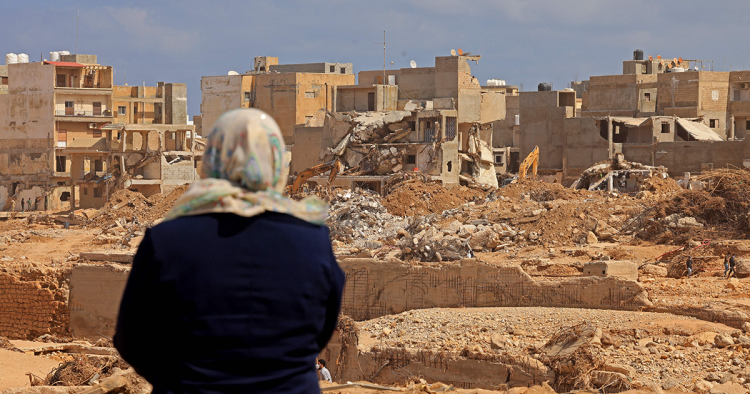After initially tracking through Greece and parts of Turkey and Bulgaria, Storm Daniel struck Libya on Sept. 10, 2023. The northeastern coast of the country was the hardest hit by the storm, especially the city of Derna, where the devastation was greatest. The city is located in a valley below two upstream dams (Abu Mansour and al-Bilad) intended to be used as sources of water supply and flood control. The storm generated strong winds and heavy rains that led to massive flooding throughout the city, washing away entire residential neighborhoods. The death toll from the floods was staggering, estimated in the thousands. This was greatly exacerbated by the collapse of the two upstream dams, Abu Mansour and al-Bilad, which were storing large volumes of water, adding to already heavy rainfall from the storm.
When the storm abated, the receding waters revealed an incredible level of destruction that affected key city services and infrastructure, such as roads, electricity, and communication lines. Local and international aid and relief organizations, including the Libyan Red Crescent, were the first responders on the ground, evacuating people, providing first aid, and conducting search and rescue operations. In the aftermath of this natural disaster, communities in Derna have faced myriad challenges, with water scarcity emerging as a critical concern. In total, about a quarter of the city was severely damaged or destroyed by the storm, devasting its critical infrastructure. The floods caused an estimated $1.7 billion in damages and losses, equivalent to 3.6% of Libya’s 2022 GDP.
Eight months on from Storm Daniel, the situation remains challenging. One of the main issues that has emerged is the pollution of groundwater resources. This has deprived city residents of access to clean water and has resulted in health problems: In the wake of the flood, 4,464 cases of acute diarrhea were reported due to the lack of access to clean drinking water. This has raised concerns over the viability of existing and alternative water resources to meet the needs of the local population. The total estimated losses and damage to water and sanitation infrastructure in Derna are the highest among the municipalities affected by Storm Daniel in northeastern Libya, at more than $77 million. UN reports revealed that the capacity of Derna’s desalination plant, located in the eastern part of the city in one of the most affected areas, dropped by more than half, from 40,000 to 16,000 cubic meters a day, due to storm damage. The reports also noted that local authorities have made progress when it comes to debris clearance and disposal, reconstruction of water pipelines and boreholes, and restoration of electricity with the support of humanitarian partners. The process of reconstructing Derna began six months after the disaster, including the central areas of the city and new housing units that will be allocated to people who were displaced or whose homes were destroyed by the storm.
Addressing the fragile water situation in Derna requires continuous monitoring and huge investments in restoring and enhancing the city’s water quality and infrastructure. With the contamination of groundwater aquifers, there was a lack of alternative water supply, since desalination had not been prioritized as a water source. Thus far, restoration efforts have targeted water and sanitation infrastructure, but challenges persist in maintaining and operating the repaired sewage and water networks due to capacity constraints and a lack of sanitation equipment. To prevent the spread of waterborne diseases following the disaster, measures like strengthening water quality monitoring systems, conducting regular testing, implementing water treatment protocols, and deploying wastewater treatment facilities will be essential.
One of the main factors that contributed to the scale of the destruction in Derna was weak governance by the Libyan Ministry of Water Resources and a lack of awareness programs by governing authorities like local municipalities. Water-related institutions responsible for managing water infrastructure, including maintenance of the dams, had been allocated a maintenance and modernization budget of over $6 million — money that is suspected of having been misappropriated since the dams’ collapse. Therefore, ensuring water security in Derna will require strong institutional management and oversight, as well as building capacity to maintain sustainable access to water and reliable infrastructure for communities in the city, especially in severely affected areas.
In addition, it is essential to solicit public input on water issues to empower the local community and ensure their full civil participation. Water managing institutions, including but not limited to the Libyan desalination authority, must consider empowering its management in terms of providing training programs and workshops for water professionals to build their capacity and expertise to help manage Libya’s local water resources. Thus, addressing water scarcity issues requires both developing strategies and implementing essential measures to increase resilience, especially during the reconstruction phase, as in the case of Derna.
Post-disaster reconstruction of water infrastructure provides an important opportunity to address water scarcity challenges in the city. Implementing a holistic approach focusing on enhancing water infrastructure, increasing alternative water resources, and expanding water conservation programs would allow Derna to emerge as a more climate-resilient city. Storm Daniel was a stark reminder of the level of devastation climate change can cause when coupled with weak governance and management. Moving forward, developing technical capacities should be a priority for the water authorities in Libya, drawing on both local expertise and international collaboration to build a water-secure future for Derna.
Malak Altaeb is a Non-Resident Scholar with MEI’s Climate and Water Program and an independent consultant, writer, and researcher based in Paris, France.
Photo by KARIM SAHIB/AFP via Getty Images
The Middle East Institute (MEI) is an independent, non-partisan, non-for-profit, educational organization. It does not engage in advocacy and its scholars’ opinions are their own. MEI welcomes financial donations, but retains sole editorial control over its work and its publications reflect only the authors’ views. For a listing of MEI donors, please click here.













